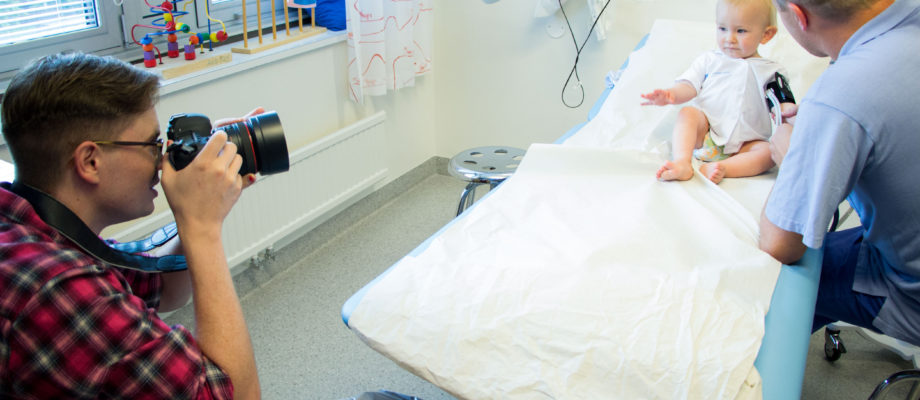EQUALITY. When the Institute of Health and Care Sciences grew tired of the standard pictures of what it is like to work in healthcare, they chose to engage gender photographer Tomas Gunnarsson. Akademiliv was on hand at Queen Silvia’s Children’s Hospital when the photos were taken.
Daniel Kjellberg recently completed his specialist training to become a pediatric nurse in Gothenburg, and is now working at one of the wards at Queen Silvia’s Children’s Hospital. In just a few months, it will be his turn to take parental leave with his youngest child, Olle, who also posed for pictures today. Daniel feels that the pictures often used today to portray pediatric care – with smiling children, soap bubbles, teddy bears and nurses playing with the children – give a lopsided view of reality.

“As nurses, we play a lot with the children to gain their trust so that we can do an examination or provide treatment, but there’s a more serious side to the work at the children’s hospital. I often hear from people who come here that they’re surprised about how sick the children actually are,” says Daniel.
Tomas Gunnarsson, who calls himself the gender photographer, listens to Daniel’s suggestions and largely agrees with him:
“At the same time, we have to be aware that it can be problematic if we put too much focus on technical equipment and seriousness. Then the observer will associate it with you being a man, and we instead risk reinforcing the gender norm. It’s a fine balancing act.”
They begin photographing the treatment room, where Olle who will soon turn one is enjoying the attention from both his dad and the photographer.
 Everyone can become a nurse
Everyone can become a nurse
The gender photographer’s pictures will be able to be seen on the Institute’s and university’s websites in digital format and also in advertisements and other printed materials.
The idea of engaging the gender photographer came up this past spring after the Institute’s Equal Opportunity Representative Lisen Dellenborg and Administrative Coordinator Karin Mossberg saw Tomas Gunnarsson hold a lecture on an education day. Institute Head Ingela Lundgren agreed that the Institute needed better pictures of the nursing profession and gave the go-ahead for the idea.
“We want to show that being a nurse is meaningful, that it’s a very important profession to be proud of and that everyone who wants to can become a nurse regardless of sex, age, ethnicity or other background. We also want the pictures to convey a more defined and competent view of nurses, although still with warmth,” says Karin Mossberg.
Engineer or nurse?
For one study* from Uppsala University, students from ten different high schools got to read about the focus, structure and content of two different, decoded educational programs. The programs later proved to be programs to become a nurse and an engineer. In the study, the students’ interest in both of the programs was equal – regardless of gender. For both boys and girls, the most important aspects were that the profession was interesting and flexible, and not what salaries looked like.
It is nonetheless significantly more common that women choose to study to become engineers than men choose to study to become nurses.

Lisen Dellenborg, Equal Opportunity Representative at the Institute of Health and Care Sciences, confirms that notions of what men and women can do strongly affect the choice of education:
“Attracting men to programs in healthcare and nursing is a societal challenge that is larger than our individual recruitment situation, but we will now in any case be able to contribute pictures that do not reinforce the notions that exist.
“A picture is worth a 1000 words. By having more pictures in society that show contrasting views of the stereotyping of the nurse as a self-sacrificing woman, motherly or sexy, but instead emphasizing the expertise it demands, how responsible and varied the nursing profession is, we can contribute to slowly changing the perception of the nursing profession, as well as the gender coding,” says Lisen Dellenborg.
TEXT AND PHOTO: ELIN LINDSTRÖM CLAESSEN
*Footnote: The study from Uppsala University is described in closer detail in the Swedish Association of Health Professionals’ book “Genusyrsel och normuppror” [Gender delirium and norm revolution] from 2013.
You can read more about Tomas Gunnarsson, Gender Photographer, here: http://www.genusfotografen.se/











